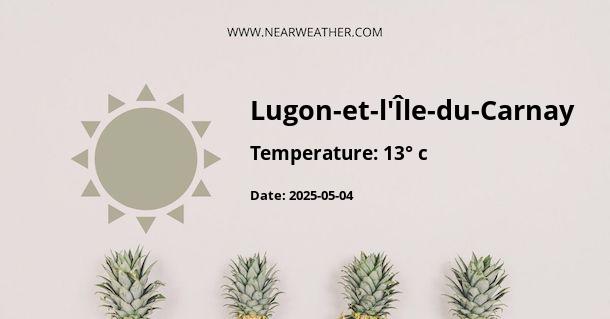Understanding the Climate and Weather Patterns of Lugon-et-l'Île-du-Carnay, France
The picturesque commune of Lugon-et-l'Île-du-Carnay is located in the Nouvelle-Aquitaine region of western France. Its climate is a significant factor in the lifestyles, agriculture, and tourism sector of the area. In assessing the climate and weather year-round, we delve into detailed meteorological data, capturing the essence of each season and what it brings to the local environment and the inhabitants.
Geographical Influence on Climate
Before providing an in-depth look into Lugon-et-l'Île-du-Carnay's weather, we must acknowledge the geographical factors influencing its climate. The proximity to the Atlantic Coast and the Gironde estuary facilitates a temperate climate moderated by the maritime influences. These factors contribute to relatively mild winters and pleasantly warm, but not excessively hot, summers.
Climate Classification and Averages
Lugon-et-l'Île-du-Carnay's climate can be classified as an oceanic climate (Cfb) according to the Köppen-Geiger climate classification. To paint a clearer picture, let us delve into seasonal statistics:
Temperature Averages
| Season | Average High (°C) | Average Low (°C) |
|---|---|---|
| Spring | 16-20 | 6-10 |
| Summer | 24-27 | 13-15 |
| Autumn | 18-21 | 9-12 |
| Winter | 9-11 | 2-4 |
Precipitation Patterns
Lugon-et-l'Île-du-Carnay experiences consistent precipitation throughout the year, with an average rainfall of approximately 800-900mm annually. There is not a distinct dry season, but the area tends to receive slightly less rainfall during the summertime.
Month-by-Month Weather Snapshot
- January: The coldest month of the year, with occasional frost and rare snowfall.
- February: Similar to January, though with increasing daylight hours and slightly higher temperatures.
- March: Marks the beginning of spring. Temperature begins to rise, although late cold snaps can occur.
- April: Spring is in full swing. A noticeable increase in temperatures and days are longer.
- May: Pleasantly warm, with greenery flourishing and occasional rain showers.
- June: The start of summer. Warmer temperatures and longer days with sporadic thunderstorms.
- July: Typically the warmest month, with temperatures ranging between moderate to high accompanied by summer rain.
- August: Continues July's trend, however, can bring some of the year's most extreme temperatures or precipitations.
- September: Beginning of autumn. Temperatures start to mildly drop, and days begin to shorten.
- October: Noticeable change in weather, with temperatures dropping and increased precipitation.
- November: Cool and often damp as the area heads towards winter.
- December: One of the darkest and coldest months, yet festive activities make it a vibrant time of year.
Extreme Weather and Climate Events
While Lugon-et-l'Île-du-Carnay enjoys a relatively mild climate, it is not impervious to extreme weather events, such as:
- Heatwaves during the summer months, which have become more frequent in Europe, including France.
- Intense storms arriving from the Atlantic Ocean, which can lead to flooding, especially during autumn and winter.
- Occasional cold snaps in the winter that may bring snowfall and ice, although this is less common.
It is important for those who live in or visit Lugon-et-l'Île-du-Carnay to stay informed about potential extreme weather, especially in light of climate change, which has caused shifts in weather patterns and an increase in weather-related disasters globally.
Weather Impacts on Local Life and Industry
The climate in Lugon-et-l'Île-du-Carnay supports a vibrant agricultural sector, which includes vineyards that produce some of the region's renowned wines. The weather also impacts the daily lives of residents and the experience of tourists. Here's how:
- Agriculture: The grapevines in the region thrive due to the consistent rainfall and sufficient sunshine, particularly in the summer. The temperate climate also supports other forms of farming, such as cereals and sunflowers.
- Tourism: Seasonal variations influence tourist activities. Summers are ideal for wine tours and outdoor adventures, while winter's mild climate makes it more comfortable for scenic walks and holiday markets than in other regions of France.
- Local Lifestyle: The weather permits a lifestyle that enjoys outdoor activities year-round, with gardens, parks, and public spaces being used continually, thanks to the moderate temperatures.
Long-term Climate Considerations
As with many locations globally, long-term climate predictions for Lugon-et-l'Île-du-Carnay consider the possible effects of climate change. Models suggest an increase in temperatures, potentially leading to heatwaves and altered precipitation patterns. These changes could affect the local agriculture, ecology, and daily life, necessitating adaptive measures and sustainability practices.
It's essential to monitor localized climate data and engage with proactive environmental management to ensure that Lugon-et-l'Île-du-Carnay continues to thrive amidst global climate changes. Weather information plays a crucial role in developing strategies to mitigate the adverse effects of extreme weather while preserving the natural beauty and cultural heritage of this unique French locale.
Final Thoughts
In conclusion, Lugon-et-l'Île-du-Carnay, with its oceanic climate, experiences a range of weather events throughout the year, from mild winters to warm summers, interspersed with regular rainfall. The climate shapes the local way of life and supports a diverse array of flora and fauna. Despite the current stability, ongoing climate monitoring and sustainable practices are imperative to mitigate the potential impact of global climate change.
A - Lugon-et-l'Île-du-Carnay's Latitude is 44.955559 & Longitude is -0.336110.
A - Weather in Lugon-et-l'Île-du-Carnay is 9° today.
A - Climate Conditions in Lugon-et-l'Île-du-Carnay shows clear sky today.
A - Humidity in Lugon-et-l'Île-du-Carnay is 99% today.
A - Wind speed in Lugon-et-l'Île-du-Carnay is 11.59 km/h, flowing at 34° wind direction. today.
